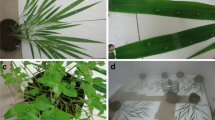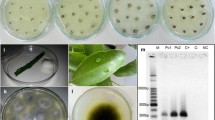Abstract
Postbloom fruit drop (PFD), an important disease caused by Colletotrichum spp., affects citrus yields in Brazil. PFD is characterised by the presence of necrotic lesions on the petals and stigmas of citrus flowers and by the subsequent abscission of young fruit. PFD epidemics have high disease progress rates, which is unusual for a pathogen that produces acervuli and is dispersed by rain. It is possible that other dispersal agents, such as insects and pollen, are involved in the spread of this disease. The objective of this work was to test whether citrus pollen grains can be colonised by Colletotrichum acutatum. Studies using light and electron microscopy showed that the pollen of Citrus sinensis can be infected by C. acutatum. This pathogen can penetrate and colonise citrus pollen grains 24 h after inoculation with the pathogen. The germ tube of conidia either penetrates the pollen sporodermis directly or passes through pollen germ pores. A single hypha can colonise more than one pollen grain. On the surface of the stigma, conidium formation can be observed. This study shows that Citrus sinensis pollen may, in fact, play a role in the spread of C. acutatum in citrus orchards.

Similar content being viewed by others
References
Agostini, J. P., Gottwald, T. R., & Timmer, L. W. (1993). Temporal and spatial dynamics of postbloom fruit drop of citrus in Florida. Phytopathology, 83, 485–490.
Agrios, G. N. (2008). Plant pathology. San Diego: Academic.
Card, S. D., Pearson, M. N., & Clover, G. R. G. (2007). Plant pathogens transmitted by pollen. Australasian Plant Pathology, 36, 455–461.
Chou, C. M., & Preece, T. F. (1968). The effect of pollen grains on infections caused by Botrytis cinerea Fr. Annals Applied Biology, 62, 11–22.
Denham, T. G., & Waller, J. M. (1981). Some epidemiological aspects of post-bloom fruit drop disease (Colletotrichum gloeosporioides) in citrus. Annals of Applied Biology, 98, 65–77.
Feichtenberger, E., Bassanezi, R. B., Sposito, M. B., & Belasque, J., Jr. (2005). Doenças dos Citros (Citrus spp.). In H. Kimati, L. Amorim, J. A. M. Rezende, A. Bergamin Filho, & L. E. A. Camargo (Eds.), Manual de Fitopatologia: Doenças das Plantas Cultivadas (pp. 239–269). São Paulo: Editora Agronômica Ceres Ltda.
Horridge, G. A., & Tamm, S. L. (1969). Critical point drying for scanning electron microscopy study of ciliar motion. Science, 13, 817–818.
Huang, H. C., & Kokko, E. G. (1985). Infection of alfafa pollen by Verticillium albo-atrum. Phytopathology, 75, 859–865.
Huang, H. C., Richards, K. W., & Kokko, E. G. (1986). Role of leafcutter bee in dissemination of Verticillium albo-atrum in alfafa. Phytopathology, 76, 75–79.
Huang, H. C., Kokko, E. G., & Erickson, R. S. (1997). Infection of alfalfa pollen by Sclerotinia sclerotiorum. Phytoparasitica, 25, 17–24.
Huang, H. C., Kokko, E. G., Erickson, R. S., & Hynes, R. K. (1998). Infection of canola pollen by Sclerotinia sclerotiorum. Plant Pathology Bulletin, 7, 71–77.
Huang-Chang, H. C., Kokko, E. G., & When, H. J. (2003). Infection of alfafa (Medicago sativa L.) pollen by mycoparasitic fungi Coniothyrium minitana Campell and Gliocladium catenulatum Gilmn and Abbott. Revista Mexicana de Fitopatologia, 21, 117–122.
Karnovsky, M. J. (1965). A formaldehyde-glutaraldehyde fixative of high osmolality for use in electron microscopy. Journal of Cell Biology, 27, 137–138.
Knox, R. B., & Heslop-Harrison, J. (1970). Pollen-wall proteins: localization and enzymic activity. Journal of Cell Science, 6, 1–27.
Krause, D. R., Wood, C. J., & Maclean, D. J. (1991). Glucoamylase (exo-1,4-α-d-glucan-glucanohydrolase, EC 3.2.1.3) is the major starch-degrading enzyme secreted by the phytopathogenic fungus Colletotrichum gloeosporioides. Journal of General Microbiology, 137, 2463–2468.
Lima, W. G., Spósito, M. B., Amorim, L., Gonçalves, F. P., & De Filho, P. A. M. (2011). Colletotrichum gloeosporioides, a new causal agent of citrus post-bloom fruit drop. European Journal of Plant Pathology, 131, 157–165.
Lin, Y. J., Stover, E., Sonoda, R., & Rosskopf, E. (2001). Stigma and style necrosis is associated with postbloom fruit drop disease in citrus following artificial inoculation. Hortscience, 36, 1138.
Ma, P., Huang, H. C., Kokko, E. G., & Tang, W. H. (2000). Infection of cotton pollen by Verticillium dahlia. Plant Pathology Bulletin, 9, 93–98.
Malerbo, D. T. S., Nogueira-Couto, R. H., & Couto, L. A. (2004). Honey bee attractants and pollination in sweet orange, Citrus sinensis (L.) Osbeck, var. PERA-RIO. Journal of Venomous Animals and Toxins including Tropical Diseases, 20, 144–153.
Olivier, R. L. (1978). Retiarius gen. nov.: Phyllosphere fungi which capture wind-borne pollen grains. Transactions of the British Mycological Society, 71, 193–201.
Parberry, D. G., & Blakeman, J. P. (1978). Effect of substances associated with leaf surfaces on appressorium formation by Colletotrichum acutatum. Transactions of the British Mycological Society, 70, 7–19.
Peña, J. E., & Duncan, R. (1989). Role of arthropods in the transmission of post bloom fruit drop. Proceedings of Florida State Horticultural Society, 102, 249–251.
Peres, N. A., Timmer, L. W., Adaskaveg, J. E., & Correll, J. C. (2005). Lifestyles of Colletotrichum acutatum. Plant Disease, 89, 784–796.
Podila, G. K., Rogers, L. M., & Kolattukudy, P. E. (1993). Chemical signals from avocado surface wax trigger germination and appressorium formation in Colletotrichum gloeosporioides. Plant Physiology, 103, 267–272.
Sakai, W. S. (1973). Simple method for differential staining of paraffin embedded plant material using toluidine blue O. Stain Technology, 48, 247–249.
Shaw, D. E. (1999). Bees and fungi with special reference to certain plant pathogens. Australasian Plant Pathology, 28, 269–282.
Stelfox, D., Williams, J. R., Soehngen, U., & Topping, R. C. (1978). Transport of Sclerotinia sclerotiorum ascospores in rapeseed pollen in Alberta. Plant Disease Reporter, 62, 576–579.
Strasburger, E. (1913). Handbook of practical botany. London: George Allen and Company Ltda.
Sutton, D. C., & Deverall, B. J. (1983). Studies on infection of bean (Phaseolus vulgaris) and soybean (Glycine max) by ascospores of Sclerotinia sclerotiorum. Plant Pathology, 32, 251–261.
Timmer, L. W. (1999). Diseases of fruit and foliage. In L. W. Timmer & L. W. Duncan (Eds.), Citrus health management (pp. 107–115). St. Paul: APS Press.
Yamakawa, T. (1984). The effect of pollen on the infection of fruit vegetables with conidia of Botrytis cinerea. Proceedings of Kansas Plant Protection Society, 26, 1–8.
Acknowledgments
This project was supported by FAPESP (São Paulo Council for Research) (Proc: 2008/54176-4; 2009/00425-6) and Fundo de Defesa da Citricultura, FUNDECITRUS, Araraquara, SP, Brazil.
Author information
Authors and Affiliations
Corresponding author
Rights and permissions
About this article
Cite this article
Marques, J.P.R., Amorim, L., Spósito, M.B. et al. Infection of citrus pollen grains by Colletotrichum acutatum . Eur J Plant Pathol 136, 35–40 (2013). https://doi.org/10.1007/s10658-012-0078-2
Accepted:
Published:
Issue Date:
DOI: https://doi.org/10.1007/s10658-012-0078-2




